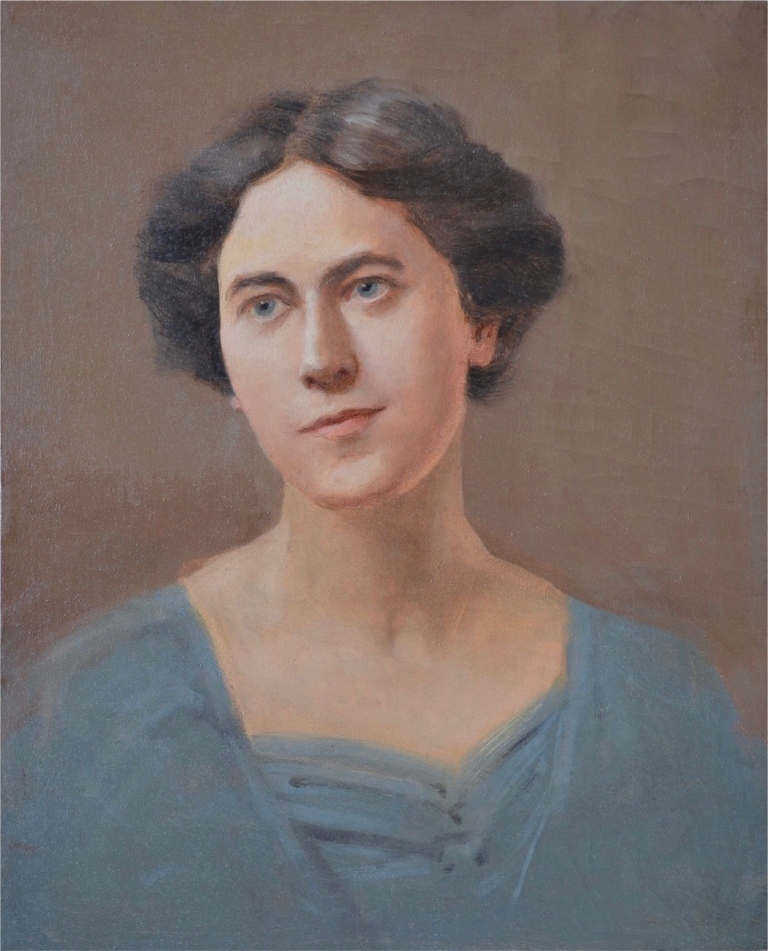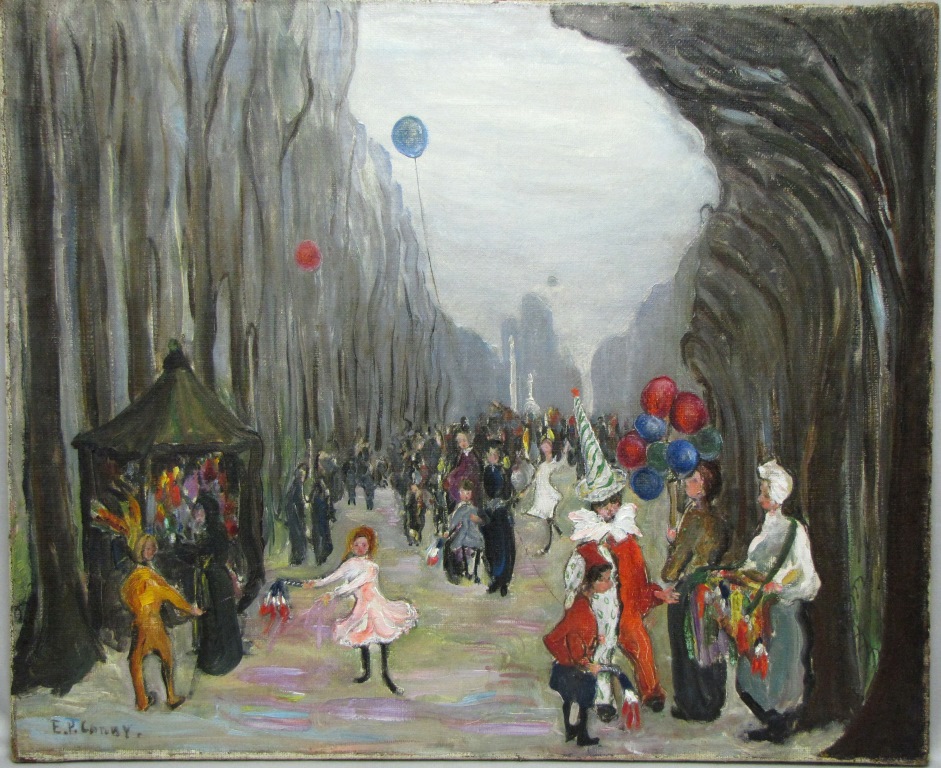“Rose Color to Gold to Glowing Red: Orville and Ethel Peets in Paris 1913-1914”
¨ New exhibit now open at Lewes, Del.’s Zwaanendael Museum
 Portrait of Ethel Canby Peets by Orville Peets.
Portrait of Ethel Canby Peets by Orville Peets.
(DOVER, Del.—Feb. 22, 2017)—The Zwaanendael Museum in Lewes, Del. is currently featuring a new exhibit entitled “Rose Color to Gold to Glowing Red: Orville and Ethel Peets in Paris 1913-1914.” Planned and created by the Delaware Division of Historical and Cultural Affairs, the exhibit features 15 paintings—eight works by Orville Houghton Peets (1884-1968) and seven works by his wife Ethel Canby Peets (1877-1955). Also displayed are an assemblage of painting materials used by the noted Delaware artists including paint brushes and palettes.
Ethel and Orville Peets are credited with bringing fresh, modern ideas to Delaware after their move to Herring Creek near Millsboro in the 1930s. They each influenced the local art-scene in a profound and lasting manner by creating art, teaching classes and holding art forums. Between 2004 and 2007, more than 400 pieces of the couple’s multimedia artwork and artists’ supplies were donated to the collections of the State of Delaware by the Peets’ longtime friends Skipper and Til Purnell.
 “Mardi Gras” By Ethel Canby Peets.
“Mardi Gras” By Ethel Canby Peets.
“Rose Color to Gold to Glowing Red: Orville and Ethel Peets in Paris 1913-1914” opened on Feb. 15, 2017 and will be on display through Dec. 31, 2017 at the Zwaanendael Museum, located at 102 Kings Highway in Lewes, Del. Museum operating-hours from Nov. 1 through March 31 are Wednesdays through Saturdays, 10 a.m. to 4:30 p.m. From April 1 through Oct. 31, museum operating-hours are Tuesdays through Saturdays, 10 a.m. to 4:30 p.m., and Sundays, 1:30 to 4:30 p.m. Admission is free and open to the public. For additional information, call 302-645-1148.
About the artists …
Ethel Poyntell Canby (1877–1955) started her art training at the Clawson S. Hammitt School of Art in Wilmington and became friends with fellow artists Ethel P. Brown and Brown’s future husband William Leach. Canby went on to studies at the Pennsylvania Academy of Fine Arts and, informally, with Howard Pyle in Wilmington. She later travelled to Paris to study at the Académie Moderne and kept a detailed diary of those years. Her work was twice awarded prizes by the Wilmington Society of the Fine Arts and was exhibited at the Baltimore Museum of Art.
Orville Houghton Peets (1884–1968) studied art in Paris at the Académie Julien and the École des Beaux-Arts. He exhibited across the United States and won numerous prizes for his prints and oil paintings. In Delaware, he organized the Wilmington Print Club, taught at the Wilmington Academy of Art, exhibited at the Wilmington Society of the Fine Arts and was a primary artist for the State Portrait Commission for which he was commissioned to paint 14 portraits. His works are in the collections of the Cleveland, Philadelphia and Baltimore museums of art; the University of Delaware; the Rehoboth Art League and the State of Delaware.
Orville was a “Renaissance man” with a wide variety of interests. Among other activities, he taught Spanish conversation classes at the Rehoboth Art League and was an active member of the Sussex Archaeological Society where he served as editor of the organization’s newsletter.
An artistic couple …
Orville Peets met both Ethel Canby and her friend Ethel P. Brown (Leach) in Paris in 1913 and taught them etching techniques. After returning to the United States, Canby and Peets were married on Sept. 23, 1914 shortly after the outbreak of World War I. Orville served in the U.S. Army after America entered the war in 1917. After the conflict, the couple moved back to France, exhibited in various salons and travelled to Portugal in the 1920s. Moving to the art colony of Woodstock, N.Y. around 1930, they became a vital part of the printmaking scene.
By the mid-1930s, Orville and Ethel had moved to the home they called Thorneby on Herring Creek near Millsboro, Del. Both exhibited their art work and volunteered at the Village Improvement Association in Rehoboth Beach. They were instrumental in the founding of the Rehoboth Art League with Louise C. Corkran and their old friend Ethel Leach. Each of them signed the Art League’s “Doors of Fame” at the dedication ceremonies on June 18, 1938, and each continued to exhibit their work and teach at the facility.
The Zwaanendael Museum was built in 1931 to commemorate the 300th anniversary of the state's first European colony, Swanendael, established by the Dutch along Hoorn Kill (present-day Lewes-Rehoboth Canal) in 1631. Designed by E. William Martin (architect of Legislative Hall and the Hall of Records in Dover), the museum is modeled after the town hall in Hoorn, the Netherlands, and features a stepped facade gable with carved stonework and decorated shutters. The museum’s exhibits and presentations provide a showcase for Lewes-area maritime, military and social history.
 Zwaanendael Museum
Zwaanendael Museum
The Zwaanendael Museum is administered by the Division of Historical and Cultural Affairs, an agency of the State of Delaware. The division enhances Delaware’s quality of life by preserving the state’s unique historical heritage, fostering community stability and economic vitality and providing educational programs and assistance to the general public on Delaware history and heritage. The division’s diverse array of services includes administration of the state historic preservation office, operation of museums and a conference center, conservation of the state’s archaeological and historic-objects collections and management of historic properties across Delaware. Primary funding for division programs and services is provided by annual appropriations from the Delaware General Assembly and grants from the National Park Service, Department of the Interior, a federal agency. However, the contents and opinions expressed in the division’s programs and services do not necessarily reflect the views and policies of the Department of the Interior.
Comments (103)
-
Guest - xukaimin
Permalinkhttp://www.chopardjewelrys.com
http://www.gucci.in.net
http://www.adidascrazy.us
http://www.niketnrequinpascher.fr
http://www.dsquared2outlet.us.com
http://www.boseheadphones.us.com
http://www.michaelkorsoutletmacys.us.com
http://www.championclothing.us.com
http://www.pandorauk.co.uk
http://www.giuseppezanotti-outlet.us.com
http://www.kate-spadeoutlet.com.co
http://www.adidasstore.us.org
http://www.uggs-outletboots.in.net">http://www.uggs-outletboots.in.net
http://www.chanelhandbags.com.co
http://www.onverseallstar.fr
http://www.dysonhairdryer.us.com
http://www.mulberryoutlet.me.uk
http://www.dieseljeans.us.com
http://www.burberryoutletonline.org
http://www.louboutin-pas-cher.fr
http://www.stuart-weitzman.org
http://www.nikestoreuk.co.uk
http://www.wedding--dresses.net
http://www.yvessaintlaurent.us.com
http://www.truereligionoutlets.in.net
http://www.ghdhair.us.com
http://www.furla.us.com
http://www.pandora-jewelry.us.com
http://www.oakleysunglassesweb.us.com
http://www.asicso.com
http://www.asicsgel.us.com
http://www.chloehandbags.us.com">http://www.chloehandbags.us.com
http://www.kobe-11.com
http://www.chloesunglassess.com
http://www.cheap-jordans.in.net
http://www.burberryclothing.com
http://www.vans--shoes.com
http://www.oakleysunglassesoutlet.us.org
http://www.franceworldcupsoccerjersey.com
http://www.guccioutletonline.in.net
http://www.guess-factory.org
http://www.fitflop.me.uk
http://www.portugalworldcupjersey.com
http://www.chaussure-nike-pas-cher.fr
http://www.poloralphlaurenboutique.fr
http://www.airmax2017.org
http://www.fendi.in.net
http://www.iphonecases.us
http://www.nikekyrie2.us.com
http://www.rosherun.us.org
http://www.jordans.com.es
http://www.karenmillen.org.uk
http://www.hermesoutlets.us.org
http://www.puma--shoes.com
http://www.skecherssneakers.us.com
http://www.coachsaleoutletonline.us.com
http://www.nikeairforce.in.net
http://www.ferragamosunglasses.us
http://www.oakleysunglassessale.name
http://www.christian--louboutin.net
http://www.airmax2018.us.org
http://www.curry2.us.com
http://www.antoniobrownjerseys.com
http://www.replica-watches.org.uk
http://www.cheapuggboots.in.net
http://www.insanityworkout.in.net
http://www.spainworldcupjersey.com
http://www.versacehandbags.us.com
http://www.designersunglassesplus.com
http://www.nikerosherun.net
http://www.polo--ralphlauren.us.com
http://www.newbalance.org.uk
http://www.isabelmarantshoes.us
http://www.uggs-outletboots.in.net">http://www.uggs-outletboots.in.net
http://www.jordan12.in.net
http://www.lunette-oakley.fr
http://www.coachpurse.in.net
http://www.burberrysunglasses.us
http://www.jordan31.org
http://www.nike-roshe-run.me.uk
http://www.oakleys-sunglasses.net.co
http://www.ray-ban-sunglasses.org.uk
http://www.airforce1.fr
http://www.jordanforkids.us.com
http://www.sunglasses-raybans.us.com
http://www.nikeblazerpaschere.fr
http://www.prada-outlets.in.net
http://www.louboutin-pas-chere.fr
http://www.uggs--outlet.net
http://www.jerseys-fromchina.us.com
http://www.burberryoutlet.us.org
http://www.keensandals.us.com
http://www.nikeairmaxplus.us
http://www.jimmychoo.us.com
http://www.vanspas-cher.fr
http://www.barbourjacketssale.us.com
http://www.cheap-jordan-shoes.com
http://www.michaelkors--canada.ca
http://www.cartierbracelets.us.com
http://www.hollisteroutletonline.us.com
http://www.airmoreuptempo.us.com
http://www.hermesuk.me.uk
http://www.adidas--superstar.fr
http://www.tommy-hilfiger.org.uk
http://www.ferragamo.org.uk
http://www.marcjacobs-handbags.in.net
http://www.bulgarijewelry.us.com
http://www.topnikecanada.ca
http://www.poloralphlaurenitalia.it
http://www.tory--burch.org
http://www.cheapweddingdresses.org.uk
http://www.oakley--sunglasses.com.co
http://www.nike-airmax.ch
http://www.clarisonic.us.com
http://www.sacguess.fr
http://www.dansko.in.net
http://www.jordan6.in.net
http://www.christianlouboutin-outlet.in.net
http://www.nikeairmax.es
http://www.cheapbestnfljerseys.us.com
http://www.pradaoutlet.in.net
http://www.sacburberrysoldes.fr
http://www.uggs-outlet.in.net">http://www.uggs-outlet.in.net
http://www.rayban--sunglasses.org.uk">http://www.rayban--sunglasses.org.uk
http://www.montre--pascher.fr
http://www.madridjersey.us.com
http://www.chiflat-iron.us.com
http://www.giannisantetokounmpojerseys.us
http://www.longchamp-outletonline.us.com
http://www.christianlouboutinhome.com
http://www.burberryoutletonsale.us.com
http://www.kobe12.org
http://www.calvinkleinoutlets.us.com
http://www.timberland-boots.com.co
http://www.jordan32.us
http://www.balenciaga-shoes.us.com
http://www.nike--airmax.co.uk
http://www.calvinkleinjeans.us.com
http://www.airfoamposite.us
http://www.scarpe-adidas-superstar.it
http://www.poloralph-lauren-outlet.in.net
http://www.diorhandbags.us.com
http://www.cheapoakleysunglassesfreeshipping.us.com
http://www.adidas-trainersuk.co.uk
http://www.freshjiveclothing.com
http://www.barbours.us.org
http://www.hermes-birkinbags.in.net
http://www.michael-korsoutletonline.eu.com
http://www.chaussuresnikeblazer.fr
http://www.chaneloutlet.in.net
http://www.eaglesjersey.us.com
http://www.nikeshoesinc.us
http://www.diorsunglasses.com
http://www.salvatoreferragamo.us.org
http://www.jordan6.us
http://www.mizunorunning.us.com
http://www.conversechucktaylor.us
http://www.reebok-outlet.in.net
http://www.longchampbagsoutlet.us.com
http://www.fendisunglasses.us
http://www.chromeheartssale.us.com
http://www.abercrombieoutlet.us.org
http://www.poloralph.in.net
http://www.christian--louboutin.it
http://www.dakprescottjerseys.us
http://www.michaelkorspascher.fr
http://www.canada-goosejackets.net.co
http://www.monclerjackets.us.org
http://www.tommy--hilfiger.fr
http://www.airmax-90.co.uk
http://www.saclongchampspascher.fr
http://www.lebron-11.net
http://www.adidasoutletstoreonline.us.com
http://www.10deepclothing.us
http://www.nikeair-max.net
http://www.timberlandpas-cher.fr
http://www.lululemonoutletsale.us.com
http://www.yeezyshoe.us.com
http://www.nikestore.us.org
http://www.insanity.in.net
http://www.jordan8.us.com
http://www.converse--shoes.us
http://www.englandworldcupsoccerjersey.com
http://www.michaelkorsoutletbest.us.com
http://www.kd10elite.us
http://www.airmax.in.net
http://www.dolcegabbana.in.net
http://www.jordan1.us.com
http://www.adidassoccer.us.com
http://www.macmakeupuk.co.uk
http://www.kristapsporzingisjerseys.us
http://www.kyrie4store.us.com
http://www.manoloblahnik.us.com
http://www.kyrieirvingjerseys.com
http://www.sacvanessa-bruno.fr
http://www.ballyshoes.us
http://www.tiffanycojewelry.us.com
http://www.toryburch-outlet.net
http://www.abercrombieandfitch.us.com
http://www.jordan9.us
http://www.bottegavenetasunglasses.com
http://www.lululemon.us.org
http://www.pandora-bracciali.it
http://www.kevindurant-shoes.net
http://www.jordan14.us
http://www.dolceandgabbanasunglasses.com
http://www.montrespas-cher.fr
http://www.reebok.us.org
http://www.karenmillen.us.com
http://www.jordan7.us.com
http://www.scarpe-nike-store.it
http://www.adidasflipflops.us
http://www.dsquared2jeans.us
http://www.armanisunglasses.us
http://www.retro-jordan.us.com
http://www.jordans.pt
http://www.fitflops.me.uk
http://www.weddingdresses.me.uk
http://www.montblancpen.com.co
http://www.bracelet-pandora-bijoux.fr
http://www.cheaptoms.us.com
http://www.ralphlauren-outlet.in.net
http://www.longchampsacpascher.fr
http://www.burberrybags.net.co
http://www.nikeairforce.us.com
http://www.replica--watches.com
http://www.nikeoutletonline.net
http://www.lacostejeans.com
http://www.miumiushoes.us.com
http://www.marcjacobs-handbags.us.com
http://www.supra--shoes.com
http://www.carsonwentzjerseys.us.com
http://www.soccerjerseys.in.net
http://www.tods-shoes.us.com
http://www.brandsglasses.com
http://www.lunette-rayban-pas-cher.fr
http://www.cheapairjordanshoes.us.com
http://www.basketsstore.fr
http://www.lunetteraybanpascher.fr
http://www.converse.us.org
http://www.valentinoshoesonsale.us.com
http://www.swarovski-gioielli.it
http://www.kevindurantjerseys.us
http://www.michaelkorsoutletus.us.com
http://www.dolceandgabbana.org.uk
http://www.jerseys.in.net
http://www.tomsoutlet.us
http://www.hollisteroutletstore.us.com
http://www.airmax-90.in.net
http://www.ferragamoshoes.us
http://www.chaussurenikeairmax.fr
http://www.new-balance-femme-574.fr
http://www.oakleysunglassesuk.me.uk
http://www.converse.org.uk
http://www.michael-kors-borse.it
http://www.michael--kors.org.uk
http://www.tommyhilfigeroutlet.net
http://www.nike--huarache.fr
http://www.uggsboots-outlet.com.co
http://www.basketballjerseys.us.com
http://www.newbalance-shoes.in.net
http://www.carrerasunglasses.us
http://www.nike-airmax-pas-cher.fr
http://www.lacosteshoes.us.com
http://www.nikefactory.us.org
http://www.herveleger.us
http://www.adidasclothing.us.com
http://www.givenchybags.us.com
http://www.nikeoutletstoreonline.org
http://www.jordan11.in.net
http://www.michael-kors-outlet.me.uk
http://www.bcbgmax.in.net
http://www.hermesjewelrys.com
http://www.ferragamohandbags.com
http://www.converseshoes.org.uk
http://www.longchamphandbagoutlet.us.com
http://www.michaelkors-outlet-canada.ca
http://www.swarovskicrystaljewelry.me.uk
http://www.uggjimmychoocheap.com
http://www.hermes.org.uk
http://www.bapeclothing.us
http://www.jbl.us.com
http://www.vans-scarpe.it
http://www.pandorajewelrys.us.com
http://www.adidas.in.net
http://www.airjordan.org.uk
http://www.hufclothing.us
http://www.jordans.com.de
http://www.ghdhair.me.uk
http://www.jordan3.us
http://www.nike-freerun.com
http://www.ralphlauren-outlet.co.uk
http://www.baseball-bats.us
http://www.nike--store.fr
http://www.nike-free-run.fr
http://www.kate-spade-outlets.us.com
http://www.nikeclothing.us.com
http://www.guessfactorycanada.ca
http://www.air-jordanshoes.net
http://www.ray-bansunglassesoff.us.com
http://www.jordans.co.nl
http://www.ed-hardy.in.net
http://www.michael-korshandbagsuk.me.uk
http://www.outletvansshoes.com
http://www.beatsheadphones.in.net
http://www.toryburch-outletsonline.us.com
http://www.jordan2.us
http://www.mac-makeup.com
http://www.roshe--run.com
http://www.germanyworldcupjersey.com
http://www.marcjacobs.org.uk
http://www.coachsoutlet.us.org
http://www.guccihandbags.in.net">http://www.guccihandbags.in.net
http://www.nikeairmax.co.nl
http://www.curry5shoes.us.com
http://www.softballbats.us.com
http://www.jordanxx9.us.com
http://www.basketsnike.fr
http://www.coachoutlet-factoryoutlet.us.com
http://www.flipflop.us.com
http://www.rolex--replica.us
http://www.airmax97.in.net
http://www.adidasslides.in.net
http://www.nike-free-run.us.com
http://www.cartiersunglasses.com
http://www.kobe9shoes.net
http://www.babylissproshop.us.com
http://www.insanity.us.com
http://www.monclerjackets.me.uk
http://www.stuartweitzman.in.net
http://www.michael--kors.fr
http://www.kenzoclothing.us.com
http://www.beatsbydrdreheadphones.us
http://www.longchamp-handbagsuk.org.uk
http://www.nikeair.us.com
http://www.adidasoriginals.org.uk
http://www.nikeoutletonline.org
http://www.airzoompegasus.us
http://www.airjordanpaschere.fr
http://www.parajumpersoutlet.us.com
http://www.bvlgarisunglasses.com
http://www.seahawksjerseys.us.com
http://www.gentlemonstersunglasses.us
http://www.jordans13.us.com
http://www.hogan-outlet-online.it
http://www.balmainjeans.us
http://www.jordans4.us.com
http://www.adidas-zxflux.fr
http://www.jordan5.us.com
http://www.cheap-uggs.in.net
http://www.armanijeansoutlet.com
http://www.furlahandbags.us
http://www.salomonshoes-outlet.com
http://www.louboutinoutlet.us.org
http://www.fendi.us.org
http://www.michaeljordan.fr
http://www.watches.us.org
http://www.beats-by-dre.co.uk
http://www.pandora--charms.in.net
http://www.prada.me.uk
http://www.katespadeoutlet-onlinestore.us
http://www.oakley--sunglassesoutlet.us.com
http://www.truereligion.in.net
http://www.brazilworldcupjersey.com
http://www.nikeairforceone.fr
http://www.basketball--shoes.net
http://www.adidassoccer.in.net
http://www.newbalancetrainers.org.uk
http://www.asicstrainers.org.uk
http://www.redbottoms.in.net
http://www.rayban-sunglasses.net.co
http://www.nike-rosherun.net
http://www.vapormaxnike.us.com
http://www.g-starjeans.us.com
http://www.scarpe-hogan.it
http://www.arcteryxjackets.us.com
http://www.goldengooseshoes.us.com
http://www.louboutinshoes.org.uk
http://www.nikeairmax95.us
http://www.kobe10.us
http://www.instylerionicstyler.us.com
http://www.kd9.us
http://www.nikefree-5.com
http://www.truereligionjeansoutlet.in.net
http://www.orologi-rolex.it
http://www.bcbg.in.net
http://www.fossilhandbags.us
http://www.alexandermcqueenhandbags.com
http://www.timberland.org.uk
http://www.nikeairmaxinc.net
http://www.nikefree.in.net
http://www.dolce-and-gabbana.org
http://www.converseallstar-outlet.it
http://www.ghd-hairstraighteners.me.uk
http://www.michael--korsoutlet.ca
http://www.lebronshoes12.net
http://www.argentinaworldcupjerseys.com
http://www.poloralphlaurenoutletsale.us.com
http://www.nike-airmax.de
http://www.harrywinstonjewelrys.com
http://www.burberry-outlet-online.it
http://www.fitflopsale.net
http://www.michaelkorsoutlet.in.net
http://www.nike-mercurial.org
http://www.chloehandbags.us
http://www.nike-rosherun.fr
http://www.saclongchamp-pascher.fr
http://www.hoganshoes.us.com
http://www.aaronrodgersjerseys.us
http://www.lunetteoakleypascher.fr
http://www.boylondon.us.com
http://www.abathingape.us
http://www.soccershoes.us.org
http://www.air-max-90.fr
http://www.omegawatches.org.uk
http://www.jimmy-choo-shoes.in.net
http://www.timberland-boots.us.org
http://www.armanihandbags.us
http://www.newbalancepascher.fr
http://www.adidasoutletstores.us.com
http://www.mizunorunning-shoes.com
http://www.curry3.us.com
http://www.abercrombieand-fitch.in.net
http://www.christian--louboutin.org.uk
http://www.rolex--watches.co.uk
http://www.guccihandbags.in.net">http://www.guccihandbags.in.net
http://www.clarksshoesoutlet.us.com
http://www.guesshandbags.us
http://www.belgiumworldcupjerseys.com
http://www.jimmychoosunglasses.us
http://www.bracelet-swarovski-bijoux.fr
http://www.moncleroutlet.com.co
http://www.raybansunglassess.net.co
http://www.us-coatsjackets.com
http://www.cheap-wedding-dresses.org
http://www.kobebryantshoes10.com
http://www.lebronjames-shoes.com
http://www.adidasrunningshoes.us.com
http://www.michael-jordan.co.uk
http://www.jordan10.us
http://www.dansko-shoes.org
http://www.rayban--sunglasses.org
http://www.rayban--occhiali.it
http://www.truereligionoutlet.in.net
http://www.abercrombieoutlet.in.net
http://www.chromeheartsjewelry.us.com
http://www.airmax90.in.net
http://www.sac-michaelkors-pascher.fr
http://www.truereligion-jeans.co.uk
http://www.supra.in.net
http://www.uggs-outlet.in.net">http://www.uggs-outlet.in.net
http://www.pololacostepaschere.fr
http://www.givenchyjewelry.com
http://www.nikeair-max.it
http://www.celine-handbags.org
http://www.kevin-durantshoes.us.com
http://www.occhiali-oakley.it
http://www.cheapnfljerseys-fromchina.us.com
http://www.nikeshoes.ca
http://www.asics-gellyte.fr
http://www.ferragamobelts.com
http://www.michael-jordan.it
http://www.nike.us.org
http://www.goyardhandbag.us.com
http://www.jordan4.in.net
http://www.fivefingersshoes.org
http://www.beatspills.us.com
http://www.montre-femme-homme.fr
http://www.salvatoreferragamo-shoes.us.com
http://www.alifeclothing.us
http://www.mizunowave.net
http://www.maccosmetics-uk.co.uk
http://www.jordanclothing.us
http://www.air-max-2017.net
http://www.jameshardenjerseys.com
http://www.airmax-95.in.net
http://www.swarovskicrystaljewelrys.us.com
http://www.linksoflondon.me.uk
http://www.truereligionjeansoutlet.us.com
http://www.katespade-uk.co.uk
http://www.curry-4shoes.us.com
http://www.iphonexcase.us.com
http://www.bottegavenetahandbags.us.com
http://www.gucci-outletonline.us.org
http://www.ralph--lauren.fr
http://www.nike-mercurial-superfly.co.uk
http://www.adidasoutletstore.us
http://www.nikeblazer.in.net
http://www.nikeroshe.net
http://www.nike-free-run.co.uk
http://www.montblancpens.net
http://www.coach-factoryonline.us.com
http://www.discount-chanel.com
http://www.coachoutletshandbags.us.com
http://www.uggoutletmall.us.com
2018.10.30xukaimin0 Like -
Guest - Emily
Permalinkyou've been https://top-casino-sites.co.uk/ and also the inducement to partake in and you've made your first bet.
0 Like -
Guest - Veronica
PermalinkThen help them learn on the sport, even play the sport with them, if you want. http://robert-swanson-prostate-support-formula.over-blog.com/
0 Like -
-
My spouse and i have been absolutely thrilled when Ervin managed to finish up his web research from the precious recommendations he received when using the blog. It is now and again perplexing to just find yourself handing out information that many the rest might have been selling. And now we take into account we have you to appreciate for this. The entire explanations you made, the easy site menu, the friendships you can give support to foster – it’s many unbelievable, and it’s really making our son and us recognize that this topic is entertaining, and that is highly essential. Many thanks for everything! visit my site here – alternative medicine institute kolkata
bola tangkas asia0 Like -
I precisely desired to say thanks again. I am not sure what I could possibly have tried in the absence of those ideas contributed by you relating to such a topic. It had become a distressing condition in my view, however , being able to view the well-written tactic you processed it made me to weep over joy. Extremely grateful for your guidance and believe you realize what an amazing job you’re doing instructing others with the aid of a web site. Most likely you haven’t come across any of us. npti-natrx
0 Like -
I’m also writing to let you understand of the exceptional experience my wife’s child obtained checking your web site. She realized several issues, with the inclusion of what it’s like to possess a great coaching spirit to get many others smoothly gain knowledge of certain specialized subject matter. You really exceeded visitors’ expected results. I appreciate you for presenting these interesting, dependable, explanatory and even easy thoughts on the topic to Kate.
agen slot online0 Like -
Thank you for each of your effort on this web site. My niece takes pleasure in managing internet research and it’s really easy to see why. My partner and i notice all relating to the dynamic form you make very useful thoughts on your website and as well as boost participation from some others on the point then our favorite simple princess is truly starting to learn a lot of things. Have fun with the rest of the year. You’re the one carrying out a splendid job.
royal tangkasnet
0 Like

Leave your comments
Login to post a comment
Post comment as a guest